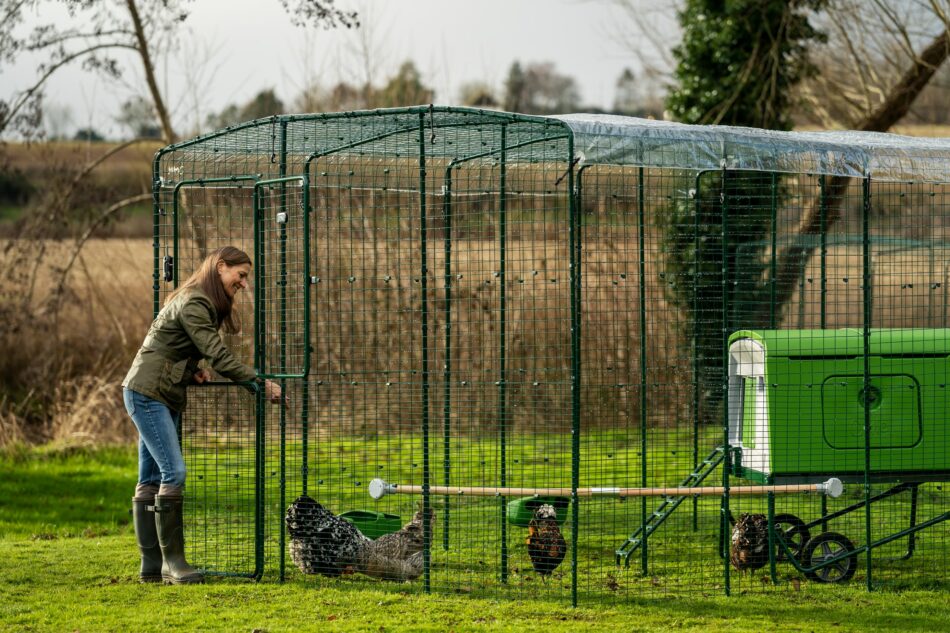Understanding the pecking order in chickens
A flock of chickens can easily give the impression of peace and equality, but they don’t start out that way. There’s a “pecking order” among chickens that is established early on and can be challenged and even changed from time to time. Every flock of chickens, whether it consists of two birds or 200, has a pecking order. This natural hierarchy determines the top and bottom-ranking hens. Understanding the pecking order in chickens will help you make decisions about housing, how to set up the run, and look out for potential trouble.
What is a pecking order in chickens?
Adherence to a pecking order is a natural behaviour in chickens and doesn’t usually require human interference. It’s established by the more dominant birds asserting themselves – and the more submissive birds will fall into line. Dominant chickens will usually be first to the feeder and to roost, but will also ensure that the lower ranking members of the flock are taken care of. Much like a monarchy, most high-ranking hens will also see that their subjects are cared for.
Chickens that are raised together from chicks will have already sorted out their pecking order. But, if you’re adding more hens to an existing flock, be prepared to witness the pecking order sort itself out all over again. Each time new members are added to the flock, the pecking order will be challenged.
Interestingly, there is circumstantial evidence that hens’ combs may play a part in the war of the wattles. Hens with large, erect combs tend to be higher in the pecking order than birds with less impressive combs. But, every flock is different, and the pecking order can be challenged and can change at any given time.
Changes in the pecking order
Occasionally, another hen may challenge the top hen for the top place in the pecking order. This is common when new hens are added to a flock, or in established flocks when dominant hens go broody, get older, or become ill. Or, sometimes lower ranking hens will simply test their place among the flock.
Generally, the most aggressive or assertive hens will be at the top of the flock’s pecking order. But, when the situation demands it, dominant hens will have to defend their place at the top. Common behaviour among hens that are working out the pecking order includes:
- Squaring off to each other – sometimes with their feathery hackles raised along their necks
- Small squabbles of pecking or feather-pulling
- A loud commotion of squawking or clucking that lasts a minute or two
Sometimes a chicken seems to rise to the top with very few pecks involved. If a dominant hen is no longer around, the pecking order enters a state of flux, and there may be new outbreaks of feathered fisticuffs before the new order establishes itself.
Occasionally, hens will be overly aggressive or will gang up on a newly added flock member, or one that’s especially timid. Keep an eye out for dangerous behaviour like:
- Excessive pecking, to the point of drawing blood or giving another hen bald patches
- Keeping lower-ranking hens away from food or water
- Pushing lower-ranking hens out of the coop at night
If you notice a hen being bullied, you’ll need to isolate them until they regain their strength. Overly aggressive hens should be kept with other strong-willed hens, and should not be allowed in with a flock of very timid hens. It’s not often that a hen will take advantage of a higher rank, but those that do are very difficult to convince otherwise.
A healthy pecking order
Being top of the pecking order doesn’t mean a hen enforces a reign of terror. Top hens protect the flock by keeping an eye open for danger, lead the flock to new food sources, and signal when it’s time to head to bed. In healthy pecking orders, dominant hens make sure that everyone is in the coop at night and has a place to roost. Make sure your chicken coop has plenty of space for everyone to have a comfortable roost at night – a nurturing dominant hen will become stressed if the rest of the flock is in a state of unrest.
If you have a rooster in your flock, they’ll almost always be at the top of the pecking order. Their natural protective instincts is what can make them aggressive (even to their human caretakers), but is also what keeps them in an elevated position in the flock. Sometimes an assertive hen can rank over a more submissive rooster, but this is very uncommon. Keeping with the rule of thumb of no less than 10 hens for each rooster in your flock will help the pecking order and the overall well-being of your hens in balance.
Be sure to give your flock plenty of room outside of the coop as well. A walk in chicken run can be expanded to accommodate growing flocks and can utilize vertical space for hens to work out their differences. Hens will maintain a healthy pecking order on their own, but by keeping their stress low and giving them plenty of space to spread out, you’ll help them keep the peace.
Your flock and Omlet
Just because chickens are self-sufficient in establishing their pecking order doesn’t mean that a little human help isn’t beneficial. By giving them a safe and roomy home like the Eglu Cube chicken coop and a spacious outdoor area with the Walk In chicken run, your flock will be comfortable and safe from external stressors that could upset their natural order. With our ingeniously designed chicken products, your chickens will be able to live their best lives as close to their innate behaviours as possible.
This entry was posted in Chickens

